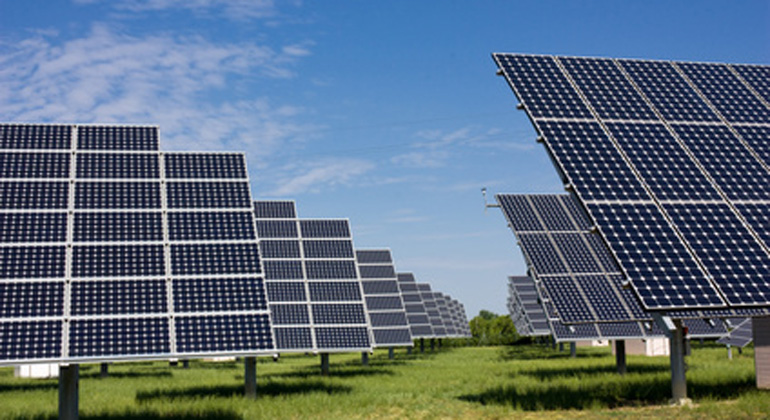Steel and Aluminum Tariffs Could Add 2 Cents per Watt to Utility-Scale Solar Projects
“That is a significant added cost, especially on top of the job-killing solar tariffs.”
President Trump announced Thursday that his administration will impose tariffs on imported steel and aluminum next week, despite strong pushback from some of his top advisers.
Trump said the U.S. will impose a 25 percent tariff on foreign-made steel and a 10 percent tariff on foreign-made aluminum, with an official announcement to come next week. It’s not yet clear if certain U.S. allies will be exempted from the tariffs, something national security experts have urged the president to do.
Beer, baseball bats and cars are just a few of the products that could get more expensive after the tariffs are put in place. Solar projects, wind turbines and energy storage units could get more expensive, too.
“Some of our installation companies have told us that the increase in the price of steel would further add to the costs of solar projects,” said Dan Whitten, vice president of communications at the Solar Energy Industries Association. “I’ve been told that at a 25 percent tariff rate, it could add as much as 2 cents a watt to the cost of a utility-scale project. That is a significant added cost, especially on top of the job-killing solar tariffs.”
The Trump administration’s 30 percent tariff on imported solar cells and modules took effect last month, and is expected to cause up to 23,000 jobs to be eliminated in the solar sector this year, according to SEIA. Losses could be lower if the industry finds innovative ways to cope with the trade restriction. U.S. solar installations are expected to slump this year, though, in part as a result of the solar tariffs. Additional price increases on steel and aluminum, which are used in ground-mount and rooftop solar racking systems, could slow deployments further.
“Steel and aluminum tariffs would be immediately impactful to the U.S. solar market,” said Scott Moskowitz, solar analyst at GTM Research. “Ground-mount systems use racks and trackers built mostly of steel. Aluminum is also common in residential and commercial rooftop racking. Most mounting structures vendors source steel and aluminum from numerous locations, both in and outside of the United States. Tariffs would likely make the cost of importing these materials prohibitive, while increasing the price of U.S.-made steel, which has already risen due to the threat of tariffs.”
The utility-scale solar market is particularly sensitive to new tariffs, Moskowitz added. The prices of trackers and fixed-tilt racking have already risen as much as 15 percent, or 1 to 2 cents per watt, over the past six months as the global price of steel and oil (the latter of which impacts shipping costs) have risen. Steel and aluminum prices started to rise last year on the anticipation of trade action.
“GTM’s latest checks indicate that such tariffs could cause an additional 2 to 4 cents per watt increase in the price of racking,” Moskowitz said.
Solar isn’t the only clean energy technology that will be affected. The majority of front-of-the-meter energy storage projects, for instance, use steel containers. GTM Research analyst Brett Simon noted the tariff could incentivize the industry to start using concrete containers instead.
“Concrete enclosures were recently introduced into the U.S. storage market, and are expected to see a 19 percent decline in containerization costs between 2017 and 2022,” he said. “As the steel tariffs will raise metal enclosure costs, the tariff will increase both the rate and speed adoption of concrete enclosures for the front-of-the-meter storage market over the next few years.”
The U.S. wind industry is also expected to take a hit from the steel import tariffs. Offshore platforms, oil drilling tubes, natural-gas turbines and pipelines will be affected, too.
The natural-gas industry spoke out against Trump’s steel tariffs Thursday, saying they will increase the cost of certain pipelines and components. Some natural-gas pipelines can be made with plastic, according to Dave McCurdy, president and CEO of the American Gas Association. However, larger-diameter high-pressure pipelines that carry higher volumes of gas across longer distances are typically made of steel. Additionally, the industry relies on steel valves that are not currently made in the U.S.
“Our operations and ongoing maintenance of the natural-gas delivery system can be severely impacted if the required materials are not readily available,” McCurdy said.
He added, however, that America’s natural-gas utilities support the president’s goals of “increasing American jobs and enhancing economic growth,” and that the natural-gas industry “will continue to work with U.S. steelmakers and pipeline manufacturers to maintain an adequate supply for our operational needs.”
The energy industry, along with many, many other industries, will be closely watching for the release of Trump’s tariff rule next week. U.S. trading partners will be watching closely too.
NAFTA partners will be pushing for tariff exemptions at next week’s trade talks. China, meanwhile, may be gearing up for an all-out trade war.







